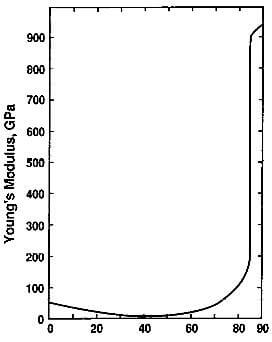As mentioned in sec.1.2, the bond between atoms within the basal plane of a graphite crystal is considerably stronger than bond between the planes with an anisotropy ratio of approximately 75. This means that, while the strength in the ab directions is considerable, that in the c direction is low and graphite shears easily between basal planes. The elastic constants are:

fig.3.13-Young’s modulus of graphite crystal as a function of angle with c axis.
C11=1060 Gpa (a direction)
C33=36.5 Gpa (c direction)
C44=4.5 Gpa (parallel to the planes)
The Young’s modulus of elasticity of the crystal varies up to two orders of magnitude with the direction. It is plotted in Fig.3.13 as a function of the angle between the c direction and the direction of measurement.
It should be noted that such values are those of the ideal graphite crystal. The mechanical properties of “real” material, such as the molded graphite materials and pyrolytic graphite are considerably different since they are controlled by the dominant crystallite orientation, porosity, structural defects and other factors. The result is large variations in the range of these properties, depending on type of graphite and process. The mechanical properties of the various forms of graphite will reviewed in details in subsequent chapters.